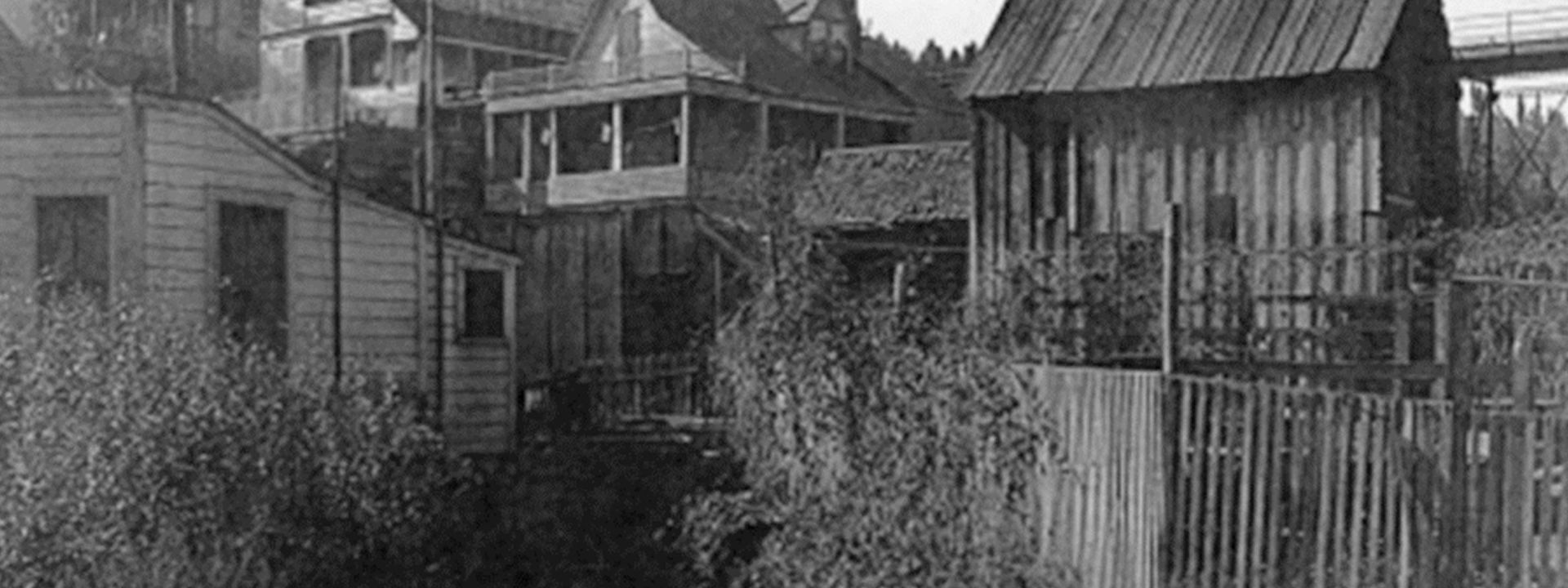
Trout Creek: A History of Misuse, Modification + Restoration
Member NewsAmong Tahoe Donner’s many wonderous natural landmarks is Trout Creek, a small tributary of the Truckee River just north of Lake Tahoe. Originating on Donner Ridge, well within the confines of the Tahoe Donner community, this small but mighty creek flows southeast for approximately five and a half miles from the Tahoe Donner Golf Course, through downtown Truckee and then east to the Truckee River, just before the 267. Its unique history has been recorded since the 1860s, conveying its misuse, modification, rerouting, and ultimately its restoration.
1860-1900s: Way Station and Logging Operations
Earliest recordings of creek impacts and misuse date back to 1863, when a man named Joseph Gray built a way station at the foot of the watershed on the California Emigrant Trail. Five years later, Elle Ellen arrived on the heels of the Transcontinental Railroad and built a sawmill. His 3.5-mile logging flume pulled water from Trout Creek and extended all the way to the railroad in Truckee, operating between 1876 and 1883.
1900s: Diverting the Creek at the Turn of the Century
According to the Truckee-Donner Historical Society, the earliest known record of Trout Creek is documented in an 1885 USGS Quad Map for Truckee, where it is shown flowing in a southeasterly direction to its confluence with the Truckee River right through the present-day historic downtown area (in the vicinity of Church and Bridge streets). This route was considerably shorter and steeper than the creek’s current flow.
A 1900s map of downtown Truckee shows a diverted Trout Creek near Jibboom Street with a northeasterly flow path, which provided a likely water source for a nearby ice pond. This diversion allowed for the development of downtown Truckee to the east of Bridge Street, and the creek was then connected to the Truckee River from there.
1900-1950s: Pollution, Disease and the Creation of Truckee Sanitation District
In 1903, Truckee experienced several major health emergencies that included outbreaks of Scarlett Fever, Smallpox, Diptheria, Typhoid Fever and Influenza. In 1907, The Truckee Republican reported the cause to be the shacks and privies that “dumped into the Trout Creek.”
Referring to it as “nothing more than a sewage ditch,” the newspaper highlighted the polluted state of Trout Creek as an ideal breeding ground for disease. Concerns of extreme health hazards led to Truckee forming the Truckee Sanitation District, and by 1909, over 17,000 feet of sewer lines were installed serving 110 buildings and two cesspools in town.
From 1930-1945, garbage was dumped from Euer Valley Road down the east flank of Trout Creek, a system that may have constituted the first organized garbage collection in Truckee’s history.
1950s-2008: Channel Impacts + Flood Danger
Given the impacts of additional re-routing between 1952 and 1966, including the completion of Interstate 80 and the extension of Bridge Street, the lower Trout Creek channel proved unstable and required ongoing maintenance. Several of the creek’s culverts restricted flood flows, increasing flood hazard in downtown Truckee. Major flood events in 1997 and 2006 indicated that significant work needed to be done to address the channel, and studies were conducted in 2002 and 2008 to assess how to manage the creek moving forward.
For more on the history of Trout Creek, visit the Truckee-Donner Historical Society’s website.
Present Day Restoration Efforts
Today, the Trout Creek Restoration Project is a collaborative effort between the Town of Truckee and other agencies to address the lower portion of the creek, including:
- Restoring the natural function of the creek
- Improving ecological value by creating riparian and aquatic habitat
- Improving water quality by managing local water runoff
- Providing flood protection
- Improving the recreational and aesthetic value of the creek
To date, four of the six defined reaches of lower Trout Creek have been restored, with the remaining two in conceptual phases. The goal of the Town is to complete the entire restoration project by 2030. Click here for more information on the Trout Creek Restoration Project.


